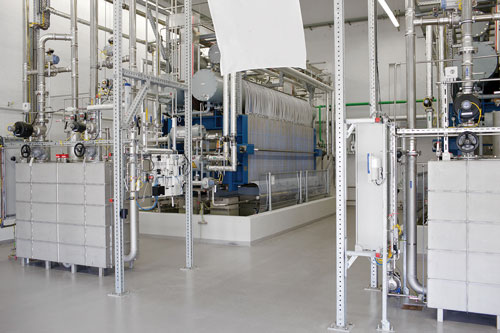Executive Viewpoint
Accelerating the future of green H2
The push for clean energy continues to drive interest in hydrogen-powered vehicles and power systems. The demand for green H2 is greater than ever before, and many consider it to be one of the most viable near-future sources of energy.
With this promising outlook ahead, the green H2 industry is a pretty exciting place to be. With the right solutions and processes in place across the supply chain, we can bring the more sustainable future of green H2 closer to reality, right now.
What makes green H2 so attractive as a renewable source of energy is that it can provide sufficient, reliable, universal power with zero emissions. Countries around the world have developed policies, programs and projects to accelerate green H2 production and use. Many governments have developed H2 roadmaps and are setting ambitious targets. With eyes on the outcome, attention on green H2 is only growing.
Since most of the infrastructure and processes required to support the transition to green H2 still need to be built, scale-up remains a challenge. The good news is that technology solutions and digital transformation that have already been proven in the greater H2 industry can help solve many of the challenges that companies across the value chain are facing now.
The process of producing H2 using water and electricity is called electrolysis. Electricity breaks down water into its base elements, H2 and O2, in a unit called an electrolyzer. These electrolyzers can range from small devices to large-scale, central production facilities. For example, skid electrolyzers can power a single factory or entire communities. By combining electrolytic cells and stacks, green H2 production can be scaled according to the needs of the application.
However, within the great advantages of scalable clean energy lie a few challenges. Research and development efforts are being made to increase electrolyzer system efficiency overall, as well as electrolyzer operating life, power density and stack size. These improvements will reduce material costs and lead to more flexible systems that are adapted to intermittent and fluctuating power supplies.
Due to the great scalability of electrolyzers, manufacturers must consider how they will access the components necessary for the full range of electrolyzer sizes. The nature of H2 adds even more complexity. It is the smallest and the lightest element and, if mishandled, the consequences can be disastrous. Electrolyzer components must be reliable and built for hazardous environments to keep people and property safe.
Working with one technology supplier that has an extensive portfolio specifically designed for H2 applications can simplify the supply chain, saving companies time and money as they scale their production. This frees equipment manufacturers and producers to focus on developing and delivering their products.

Fig. 1. It is beneficial to work with a trusted central partner across the entire H2 fuel value chain.
It is especially important to work with an expert supplier equipped with a wide range of measurement, control and electrical equipment specifically designed to improve reliability and safety in the hazardous areas of electrolyzers (Fig. 1). In addition to valves, valve systems, flowmeters, regulators and pressure transmitters, they should also have smart technologies, such as scalable process control and safety solutions that can reduce operational complexity, decrease risk and improve the performance of green H2 facilities, from electrolyzers to balance of plant assets, while providing sitewide safety system capabilities. An integrated control and safety system (ICSS) is also a critical tool to ensure optimized start/stop sequencing with embedded sequence diagnostics.
Before H2 can be used for power, it must be converted, stored or transported. With pressures of up to 15,000 psi in the value chain, H2 must be effectively, efficiently and safely controlled. No inboard or outboard leaks can occur due to integrity issues with static or dynamic seals. Even some metals can be negatively affected by prolonged exposure to H2, a process called H2 embrittlement. Risk assessments and strict regulations must also be met.
Working with H2 requires serious, dependable control to ensure that systems operate safely. Companies need to know that they do not have loss across their systems, and they need to know how much H2 is passing through transmission/transfer points. Integrating components that reliably monitor and measure H2 into systems is essential.
Every system includes certain final control elements (FCE), such as shutoff and metering valves, high-pressure regulators, pneumatic actuators and solenoid valves. Reliable, high-quality control and safety circuits provide the precision necessary to maintain appropriate pressure and flowrates and preserve H2 purity, and can be monitored remotely. Sensors should be integrated to monitor pressure, temperature and flowrates. If smart equipment is used, data can be collected to improve productivity and ensure high operational yields.
It is also important to have a supplier with a complete portfolio. What is even more important, however, is working with partners with extensive H2 experience and expertise that are familiar with the regulations and certifications. They understand the plantwide ecosystem and have the safety and controls equipment needed to monitor, measure and control H2 effectively and efficiently. They should also have the flexibility to address a vast range of designs and applications.
A key element of the transition to H2-powered vehicles is the fuel cell. Fuel cell power systems can be used to power passenger cars, commercial vehicles and more. Like electrolyzer manufacturers, fuel cell manufacturers can benefit from an expert supplier with an extensive portfolio.
For fuel cells, that portfolio should include high-reliability flow control, pressure regulators, safety junction boxes and flameproof cable glands. Designs should be compact and lightweight to enable manufacturers to create systems with high power density and extended cell life. Manufacturers can lower the risk of fuel cell system failure with solutions that provide stable pressure regulation, safe distribution and equipment connectivity.
Once H2-powered vehicles populate the road, drivers will need to refuel them. As fueling stations transition to green H2, they face sustainability, safety and maintenance challenges. One concern is accurate monitoring of H2 flow to ensure that customers dispense the right amount of fuel every time, quickly and safely. Another is accurate maintenance of the condition of fueling stations and their critical components to ensure that stations are available for users at any given time, whether they are deployed in dense or remote areas. Fueling station equipment can leverage digital transformation to solve some of these critical challenges.
Starting at the device level, smart sensor technology and the data it provides can lay the foundation on which digital transformation is built. Building on this foundation, utilizing a programmable logic controller (PLC) with integrated edge gateway capabilities can provide complete control and turn aggregated data into real-time information/analytics of the fuel dispensing process or of the condition of the system itself.
The power of digital transformation can be scaled greatly beyond just one fueling station to a vast network of stations, where information can be aggregated to help optimize the entire network. Dispensing accurate fuel volumes at the highest flowrates safely, as well as reducing the probability of leaks and monitoring the condition of the fueling station, ensures robust operation and optimal yield.
The PLC, combined with an edge gateway, can also perform analysis and visualization of diagnostic and process data, which can be provided locally to the fuel station operator and remotely to the H2 supplier, simplifying supply chain logistics. Having remote access to filling rates and preventive maintenance information means that H2 suppliers are filling tanks only when necessary and providing maintenance only when needed.
From storage tanks to tube trailers to dispensers, fueling station systems must also be safe and easy to maintain, as well as meet the highest performance and regulatory standards. To reliably protect personnel, customers and property, ultrasonic gas leak detection systems continuously monitor fueling stations for ultrasound generated from the release of pressurized gas. Pressure transmitters designed for high-pressure measurement and flowmeters specifically designed for H2 dispensing applications can accurately measure pressure and gas flow. Connecting these important devices that monitor critical parameters to a higher-layer gateway can be used to deliver real-time warnings and alerts to staff on premises or remotely, providing further safety enhancements.
The first step to sustainable success. Building the infrastructure and processes needed to transition to green H2 requires a partner that can support companies at each stage of their scale-up. Taking a scalable approach will reduce risk while making meaningful progress.

Fig. 2. Key technology partners have a broad range of equipment for measurement and control processes.
Since green H2 is still a relatively new business, companies must rely on partners with broad knowledge and expertise that have already proven themselves in the H2 industry (Fig. 2). These expert partners already know the regulations and certifications needed and how they change, depending on the region. They likely already have a physical presence to manufacture close to customers and their markets.
Emerson, for instance, has been involved in the H2 industry since its beginnings. Since that time, the company has developed full capabilities across the H2 fueling value chain around the globe. We are very excited about providing innovative solutions for other new challenges as this expanding frontier presents them.
Green H2 is exceptionally clean and efficient, but as we have seen, building the infrastructure, controlling the gas and making it available for consumption requires expertise. Companies are better equipped to forge ahead if they partner with a specialist that already has a strong presence and relevant experience, holds deep industry and regulatory knowledge and can provide the needed solutions. This strategic partnership will give them a strong position and long-lasting competitive advantage as they make the promising future of green H2 a reality.

Gordon Muir is President of Industrial Automation at Emerson Automation Solutions. He has been following the hydrogen industry for more than 15 years, with a special interest in green hydrogen. Gordon earned his MBA degree from the University of Minnesota and his BS degree in electrical and electronic engineering from the University of Strathclyde in Glasgow, Scotland.